Course:ENGL419/Books/Chinatown Tours
Welcome to the UBC Wiki page for Pender Y.W.C.A. and Chinese Merchants of Vancouver's "Chinatown Tours" booklet, circa May 6th, 1955[1]. This booklet is located in the Wallace B. Chung and Madeline H. Chung Collection at UBC's Rare Books and Special Collections, the first folder of Box 129.
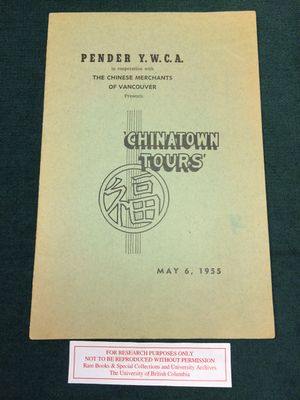
Context
Disclaimer
This wiki entry on the "Chinatown Tours" booklet is written for English 419A (The History of the Book). The author, Jane Shi, hopes to provide readers with a sense of the booklet's historical, social, and cultural significance for Vancouver's Chinatown and the Chinese community in Canada. As a Mandarin-speaking Chinese immigrant hailing from central eastern China, she relates to the Chung Collection's materials on Chinese immigration and racist exclusion chiefly as a researcher, not as an active member of the Cantonese-speaking Chinese Canadian community with historical, residential, or cultural ties to Vancouver's Chinatown. With this disclaimer in mind, she hopes readers will find this wiki illuminating.
The Value of Ephemera
In lieu of a literary book, I wanted to look through the Chung Collection for ephemera on the cultural life in Vancouver's Chinatown of the last century. The Chung collection houses an overwhelming amount of Chinatown-related materials among its archive of 25,000 plus items. Given my language limitations, I could only take up texts written in English; these only show a part of the history of Chinatown available at the Chung collection. Yet English-language textual materials on Chinatown assume a specific structural relationship to its audience and subject matter. For this reason, tracing the social history of such materials is vital for understanding the racial, political, and economic power structures underpinning Chinatown as an urban "Chinese" enclave.
Chinese authorship within white Canada
According to Pierre Bourdieu, the field of cultural production is the "site of struggles in which what is at stake is the power to impose the dominant definition of the writer and therefore to delimit the population of those entitled to take part in the struggle to define the writer"[2]. Furthermore, Bourdieu asserts that "the relationship to the audience and, more exactly, economic or political interest in the sense of interest in success and in the related economic or political profit, constitute one of the bases for evaluating the producers and their products"[3].
Positioned as ethnic others within Anglocentric white European society, Chinese authors born in and outside Canada in the 20th century are implicated in the struggle for political and legal enfranchisement just as they fight for some form of cultural legitimacy within Canadian society. The first Chinese Canadian novel published by a major Canadian publishing company is Sky Lee's 1990 Disappearing Moon Cafe. Like the novels of Wayson Choy, Disappearing Moon Cafe constructs Chinatown as the site of struggles against racism within the generic constraints of "ethnic" and historical fiction. But English-language cultural production by Chinese Canadian authors does not begin or end with the novel genre, as my findings within the Chung Collection show.
Notwithstanding, the dominant definition of the Chinese Canadian writer throughout the 20th century is one that writes about Chinatown. Given that the racist evaluations of Chinatown as a space also comes, as Bourdieu would note, with the interest in success, or in other words in political and economic profit, Chinese Canadian cultural production must participate in the “ethnic neighborhood tourism phenomenon. . . .premised on the underlying mechanism of the tourist gaze"[4]. As such, the "Chinatown Tour" booklet of May 6th, 1955 provides an excellent window into the field of cultural production for Chinese Canadian authorship, one which is heavily determined by relational and institutional demands.
Tourism in Chinatown
Kay Anderson argues that “[b]y the 1950s, the power of definition over Chinatown served the interests of white Europeans in a more explicit manner," through "urban planning ideologies" which were "plainly guided by inherited ideas about a Chinese race and place."[5] According to Anderson, the move to more liberal immigration policies in the 1950s and 1960s also came with a shift in rhetoric in how the Chinese were regarded: the term "race" was replaced with "ethnic." While subtler, this form of racism went hand in hand with the impetus for government-sponsored urban renewal that saw Chinatown solely through terms of marketability through tourism. Residential areas on the other hand were cast in the terms of "ghetto" and "slum" by the Vancouver Planning department in 1956.
While speaking in the contemporary Chicago Chinatown context, Santos et al. note that tourism discourse "is produced within an ideological milieu that is celebratory of diversity and multiculturalism and within a political–economic milieu that recognizes the marketability of diversity, draws upon traditional characterizations of Chinatown as Other while reconstructing this Otherness in a way that appears friendly to tourists" [6]. In other words, tourism at the time of the Chinatown Tours in the 1950s and 1960s and the Chinatown tours offered today both function as the "respectable" and "marketable" side of Chinatown. The other side, if the influx of condo development in Chinatown today is any indication, constitutes low-income people who live there and who have endured systematic racism as Chinese people.
Click here for a quick overview of The Wallace B. Chung and Madeline H. Chung with samples of Chinatown tourism ephemera.
About the Text
The 'Chinatown Tours' booklet consists of 13 (including the front side of the back cover) unnumbered pages of articles and ads. Each page consists of at least one advertisement for a restaurant or shop on Pender Street in Chinatown, excepting the back cover page which lists the dinner and afternoon tea menu for the Tour and the address for the booklet’s printer, Charlie Young Printing. The front and back cover consists of a single sheet of green construction paper, slightly thicker than the yellowing pages within the booklet. In pencil on the first page "1955" and "$5.00" is written. No information is given on what the price refers to.
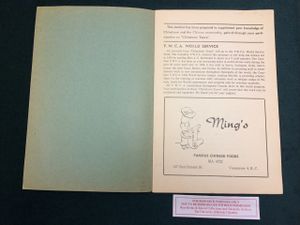
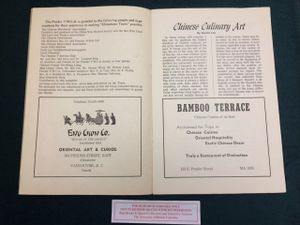
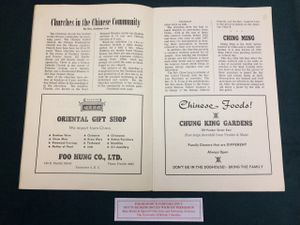

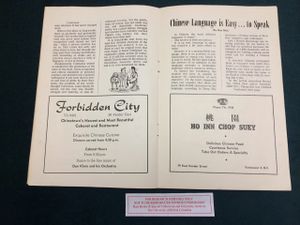
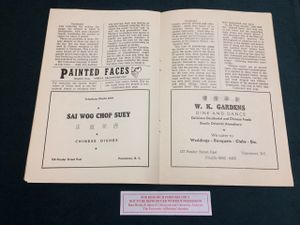
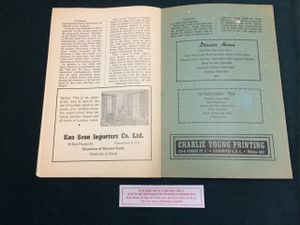
Y.W.C.A. World Service and contributors
The larger, bolded text on the cover reveals that the booklet was compiled and finalized by Pender Y.W.C.A. The first and second page also reveal that the Chinatown Tour of May 6th, 1955 was organized by the Pender Y.W.C.A. In other words, while the cover names the Chinese Merchants of Vancouver as a partner in the Tour, its organizational role and authorship of the booklet are secondary to the Y.W.C.A.
The opening page makes clear that funds earned from the Tour go to the Y.W.C.A. World Service, a “program of self help and mutual aid” that the Canadian Y.W.C.A. signed up to in 1904 “by sending Miss A.C. McDonald to Japan as a Y staff member” (1). Among notable donors and contributors of the Tour include the Chinese Merchants' Association, the Chinese Freemason's, the Hudson's Bay Co. and Famous Artists Ltd, local churches, daily and neighbourhood newspapers, and local radio stations.
Articles
The articles in this booklet are printed above the advertisements in two columns. Where an article carries on to the next page, "Continued next page" is printed at the bottom of the last column on the page and "Continued" is printed on the top of the next page.
The articles are listed here in the order they appear:
- “Chinese Culinary Art” by Harold Lim
- “Churches in the Chinese Community” by Rev. Andrew Lam
- "Ching Ming" (this small paragraph on the spring festival does not seem to be affiliated with the previous article and no author is given)
- “Chinese Character” by Harvey Lowe
- “Chinese Language is Easy… to Speak” by Roy Mah
- “Painted Faces” reprinted from “China Reconstructs”
Advertisements
The ads in the booklet are listed here in the order they appear along with their respective tagline:
- Ming’s ("Famous Chinese Foods")
- Eng Chow Co. ("Oriental Art & Curios")
- Bamboo Terrace ("Chinese Cuisine at its Best")
- Oriental Gift Shop ("We Import from China")
- Chung King Gardens ("Chinese Foods!")
- Dragon Palace ("Cabaret and Restaurant: Dine and Dance in the heart of Vancouver's Chinatown")
- Ho Ho Chop Suey ("We Serve Only Unexcelled Authentic Chinese Cuisine / Pleasant Atmosphere / Courteous Service")
- Forbidden City ("Chinatown's Newest and Most Beautiful Cabaret and Restaurant")
- Ho Inn Chop Suey ("Delicious Chinese Food / Courteous Service / Take Out Orders a Specialty")
- Sai Woo Chop Suey ("Chinese Dishes")
- W.K. Gardens ("Dine and Dance / Delicious Occidental and Chinese Foods / Exotic Oriental Atmosphere")
- Kuo Seun Importers Co. Ltd ("Emporium of Oriental Goods")
Authors and Publishers
Unlike a newspaper, journal, or magazine, the publishers of this booklet constitute not a press but rather the organizational and institutional bodies that put together the event which the pamphlet is aimed at supplementing. In other words the publisher and final 'author' of the booklet can be said to be the Pender Y.W.C.A. who put on the Chinatown Tour on May 5th, 1955. While the Chinese Merchants of Vancouver is listed on the cover as author and publisher of the booklet, their voice is not directly heard. The opening page states, on behalf of the Pender Y.W.C.A., that this "booklet has been prepared to supplement your knowledge of Chinatown and the Chinese community, gained through your participation" of the Chinatown Tours. On the other hand, since the booklet includes multiple articles written by different Chinese Canadian authors, those voices constitute a significant portion of the booklet's authorship. Furthermore, the booklet contains a reprint of an article printed in China Reconstructs, a monthly magazine founded in 1949 by Soong Ching-ling with Israel Epstein, aimed at promoting the People's Republic of China. A notable point about the local Chinatown authors included is that all of them (if one can safely assume) are men. Unlike the predominant clientele of the Pender Y.C.W.A., the authorial voices of the booklet mirror the homosocial, patriarchal order of early Chinese settlers of Canada.
According to an ad printed in Chinatown News on November 18th of 1954, previous Chinatown Tours have been hosted by the Pender Y. A photograph from January 20th, 1961 of Joyce Yip, Anita Chow, and Susan Chow dancing at a Chinatown Tour also suggests that these events were ongoing, meant to raise funds for the Y.W.C.A. World Service and to "acquaint Vancouver with the customs, language, culture, people and food of the Chinese" (Henderson 8). The February 1961 Chinatown Tours booklet, found in the Chinese Canadian Women, 1923-1967: Inspiration - Innovation - Ingenuity collection, reveals that the Tours happened annually, though it's unclear when they began or ended.
The following lists what I consider to be crucial players and contributors of the "Chinatown Tours" booklet. Where available, I have also noted the organizational affiliations of the authors of the article in order to paint a booklet's influences and authorships as stemming from a wide network of institutional bodies within and outside of Chinatown.
Pender Y.W.C.A.
In 1938, the Vancouver Y.W.C.A. set up a Chinese Department to serve Chinese women and girls. Under the leadership of Esther Fung in September, 1944 the first Chinese Y.W.C.A. would secure a space on Pender and acquire a second full-time staff worker in 1948. To meet the needs of those in the neighbourhood, the program under the name International Y.W.C.A. expanded its mandate to include women and girls from other ethnic groups (Japanese, Italians, Poles, Hungarians, etc.), which also meant that a bigger facility was needed. In 1952, the renamed "Pender Y.W.C.A" opened in a new building on Pender and Dunlevy, purchased under Mr. Lee Bick. Open to all age groups, the program served immigrant women from Hong Kong who came to learn English, provided babysitting facilities for young children, and offered clubs and summer programs for youth[7].
While the Pender Y offered services in both English and Cantonese, they were not equipped to give bilingual settlement services to new immigrants, especially new Chinese immigrants. In this sense, while the Chinatown Tours happened annually throughout the 1950s and 1960s, the Y.W.C.A. did not satisfactorily meet the needs of the Chinese community of Chinatown. As Shibao Guo notes, "a separate organization with a special mandate to service Chinese new immigrants was necessary"[8] which led to the founding of the United Chinese Community Enrichment Services Society (SUCCESS).
Chinese Merchants' Association
The other publisher of the booklet is the Chinese Merchants of Vancouver, who were Chinatown merchants of an immigrant background. Created prior to the reform of the Chinese Merchants' Association by Canadian-born Chinese in 1957, the booklet is a product of the association's post-war status as a chamber of commerce for these immigrant merchants. Founded in 1929, the Chinese Merchants' Association chiefly facilitated import-export trade[9].
While Chinatown Tours continued to be held after the reform of the Chinese Merchants' Association (renamed to Vancouver Chinese Association of Commerce) in 1957, neither the old association nor the new name appears in the February 1961 Chinatown booklet.
Harold Lim
Author of "Chinese Culinary Art," Harold Lim was one of the members of Vancouver Chinese Association of Commerce, a restauranteur at W.K. Gardens[10], and owner of the Chinatown Lions Club.
Reverend Andrew Lam
The Reverend Andrew Lam was the first Canadian-born Chinese minister in Canada. He was the rector of St. John the Baptist from 1968-74, who conducted services at the Anglican Church of Good Shepherd with the assistance of Reverend Dr. Bruce Bellegrin[11], and graduated from UBC and Anglican Theological College[12]. Throughout his life he spoke for the enfranchisement of all Chinese in Canada and emphasized integration over assimilation[13].
Harvey Lowe
According to an article in the The New Faces of Vancouver called "Chinatown: A Street of Contrasts", Harvey Lowe (1918-2009) was "a real estate agent, radio commentator, and Chinatown's best-known spokesperson"[14]. Indeed, Lowe appears to be the booklet's best known author: he was also a world yo-yo champion founded Smilin' Buddha Cabaret on Hastings Street, and became the stage manager of the Marco Polo (not yet existing in 1955). In addition he was a restauranteur at the Bamboo Terrace and the president of the Chinatown Lions Club later in life.
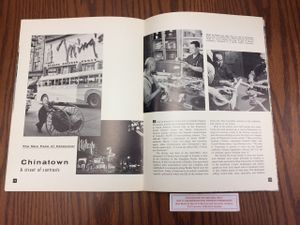
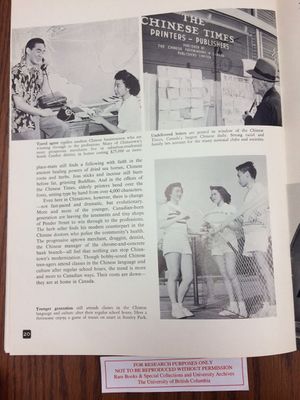
Roy Mah
Roy Mah (1918-2007) was the founder of Chinatown News and a Chinese Canadian WWII veteran.[15]. A human rights activist, Mah also fought for Chinese Canadians' right to vote and participate in the military, and founded the Chinese Cultural Association with Fred Mah (no relation to Roy)[16].
What's especially striking about the article Mah has written in the booklet is its reference to printing in relation to the Chinese language: "A standard Chinese newspaper is equipped with 8,000 characters constituting a complete set. Each set may have as many as five different sizes, much the same as an English print shop with its varying size types." Here, using his expertise as a publisher, Mah suggests the similarity between the English and Chinese print world, though the latter is far older than the former.
China Reconstructs
"Painted Faces," written by Ma Yen-hsiang, is a reprint from a monthly magazine called China Reconstructs. This magazine, renamed China Today, in 1990, was founded in 1952 by Soong Ching Ling, then vice-chairman of the Central People's Government and president of the China Welfare Institute under the recommendation of Premier Zhou Enlai. The aim of the magazine is to introduce the world to the new China[17]. Its appearance in the booklet conflates Chinatown with China on the one hand, and on the other hand, offers readers sense of mastery over Chinese culture.
Charlie Young Printing
Little information is available on Charlie Young Printing, except that it was a printing and publications shop on 122b East Pender that also printed the November 18th, and December 3rd, 1954 issue of Chinatown News[18][19] Given the subsequent consistencies of style in later issues of both the "Chinatown Tour" pamphlets and Chinatown News, Charlie Young Printing has likely printed materials on Chinatown for at least a decade or more.
The Chinese as well as the "Chew Sam" written in parenthetical suggest that Charlie Young Printing is Chinese-owned. The press was outlived (until last year, 2014) by Ho Sun Hing Printers, which opened in 1910 at 205 East Pender.
References
- ↑ Pender Y.W.C.A ; The Chinese Merchants of Vancouver. "Chinatown Tours." Box 129-1
- ↑ Bourdieu, Pierre. The Field of Cultural Production. p. 343
- ↑ ibid, p. 345
- ↑ Santos, Carla Almeida, Yaniv Belhassen, and Kellee Caton. 2008. Reimagining chinatown: An analysis of tourism discourse. Tourism management 29, (5): 1002-1012
- ↑ Anderson, Kay. Vancouver's Chinatown: Racial Discourse in Canada, 1875-1980. p. 178-9
- ↑ Santos, Carla Almeida, Yaniv Belhassen, and Kellee Caton. 2008. Reimagining chinatown: An analysis of tourism discourse. Tourism management 29, (5): 1003
- ↑ Shadbolt, Helen. Pender YWCA Chinatown Tours Souvenir Booklet, Vancouver. p. 2
- ↑ Guo, Shibao. "Responding to the Changing Needs of the Chinese Community in Vancouver: The Contribution of SUCCESS (1973-1998)." April 2004
- ↑ Ng, Wing Chung. The Chinese in Vancouver, 1945-80: The Pursuit of Identity and Power. Vancouver, BC, CAN: UBC Press, 1999. p. 43-45
- ↑ "CTN-6-9_0012." Multicultural Canada. n.d. http://www.multiculturalcanada.ca/node/209361
- ↑ "History." History. January 1, 2014. Accessed April 23, 2015. http://www.mts.net/~gdshep/history.html.
- ↑ Lam, Rev. Andrew. "Rev. Lam Urges Franchise for ‘Young’ Chinese." The Province, November 21, 1944.
- ↑ Ng, Wing Chung. "Becoming 'Chinese Canadian.' The Genesis of a Cultural Category." p.208
- ↑ Chinatown: A Street of Contrasts. The Royalite Reporter. SPAM 29639
- ↑ "Chinese Canadian Military Museum Society." Chinese Canadian Military Museum Society. Accessed April 23, 2015. http://www.ccmms.ca/veteran-stories/army/roy-mah/.
- ↑ Eustace, Chantel. "'Gentle' Man Touched so Many People's Lives." The Vancouver Sun, June 25, 2007. http://www.gunghaggis.com/2007/06/27/vancouver-sun-story-on-roy-mah-gentle-man-touched-so-many-peoples-lives/.
- ↑ "Soong Ching Ling and China Today - All China Women's Federation." Soong Ching Ling and China Today - All China Women's Federation. May 24, 2011
- ↑ "CTN-2-7_0019." Multicultural Canada. n.d. http://multiculturalcanada.ca/node/208458
- ↑ "CTN-2-7_0017." Multicultural Canada. n.d. http://www.multiculturalcanada.ca/node/208467.